Sue Burke's Blog, page 3
April 23, 2025
Barnes & Noble preorder sale – get the ‘Usurpation’ paperback
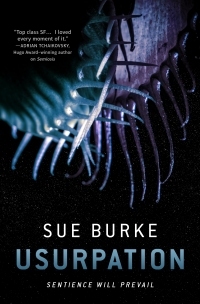
From April 23 to 25, Barnes & Noble is having a pre-order sale: 25% for B&N members for print, ebook, and audio; 35% off for Premium Members for print pre-orders only. Use the code PREORDER25
The trade paperback edition of Usurpation will be released on October 21, 2025. Plan ahead!
April 16, 2025
Stories and Matters of Size
You might have an idea for writing a work of fiction, but is it flash fiction, a short story, a novel, or an epic trilogy? It can be frustrating to begin what you hope will be a short story, but soon it’s grown too long, and you don’t have time for a novel right now. Or, you might start a novel and run out of steam because there isn’t enough of an idea to fill all those pages.
Here are a few ways to help you evaluate your idea before you start.
• How many scenes can you imagine? A novel might have 80 scenes of 1,000 words each, and a short story just a few scenes.
• How many plot points can you imagine for a three-act outline, Hero’s Journey, or other novel plotting tool? A shorter piece may have only one or two pieces of the plot.
• Can you imagine the story as a picture? The artist El Greco will help illustrate this concept.
A simple picture can be a short-short story. Boy Lighting a Candle, by El Greco, 1571.
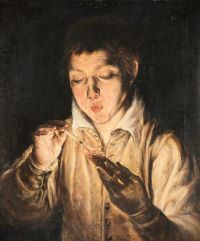
This story might be:
“The little glowing fairy was fragile and needed help to stay alive.”
Add a few more characters, and you have a longer short story. An Allegory with a Boy Lighting a Candle in the Company of an Ape and a Fool, by El Greco, 1577.
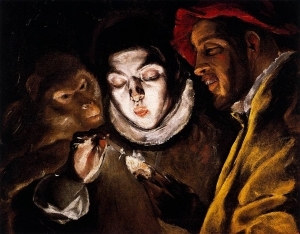
This story might be:
“The little glowing fairy was fragile, but it attracted too much attention, and the boy didn’t think he could keep it safe.”
With more characters and more conflict, you might have a novel. The Miracle of Christ Healing the Blind, by El Greco, ca. 1570.

This story might be:
“The protagonist’s unusual but successful medical techniques often got him into trouble, and eventually he faced a death sentence.”
A big canvas with a lot happening could well be a trilogy. Burial of the Count of Orgaz, by El Greco, 1586. The painting is 15 feet / 4.5 meters tall.
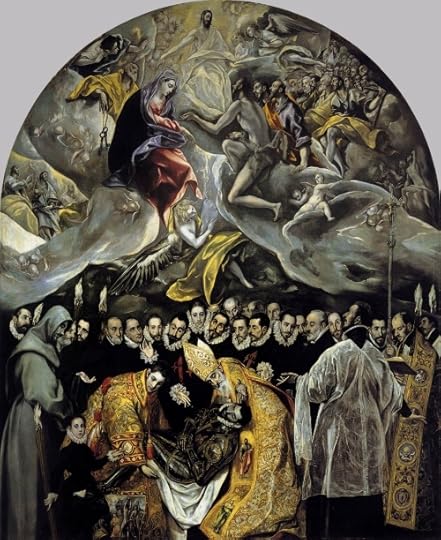
This story might be:
“The Count’s death unleashed an epic conflict between men and God.”
(Notice the lack of women at the Count’s funeral. That could become an important plot point in the story.)
Exercise
Think of an idea you’ve been playing around with. Try to imagine it as a work of art. Would it fit nicely on a postage stamp? It might be flash fiction. Would it fill a wall-sized mural? You might have an epic. The goal is to avoid unpleasant surprises when you finally start to write. If you need an idea, here are a few:
• A medical team must decide if it can ethically flee a deadly situation.
• A technology company begins to operate in increasingly illegal activities, but the change is so slow and the money is so good that one of the engineers, who becomes deeply troubled, can’t afford to quit.
• A family living in a haunted house refuses to believe in ghosts.
• Two individuals initiate a series of gift exchanges, and the gifts tell more about the givers than they realize.
• Friends witness the breakup of a family from different perspectives and have different opinions.
April 11, 2025
Heliox examines ‘Semiosis: The Intelligence We Never Saw Coming’

Helios, a substack that goes deep on big ideas, has taken a look at my novel Semiosis:
“For centuries, we’ve measured intelligence through a profoundly narcissistic lens. We’ve built entire philosophical and scientific frameworks around the idea that cognition is a uniquely human trait — a linear progression of thinking that starts with simple organisms and culminates in our own supposedly superior consciousness.
“Sue Burke’s Semiosis isn’t just a science fiction novel. It’s a radical dismantling of those comfortable delusions.”
Besides an article and podcast, there are study materials: References, Executive Summary, Briefing Document, Quiz, Essay Questions, Glossary, Timeline, Cast, FAQ, Table of Contents, Index, Polls, 3k Image, and Fact Check.
You will find spoilers — and a lot to think about.
***
My translation of “The Coffee Machine” by Celia Corral-Vázquez has been nominated for the 2024 Best Translated Short Fiction Award by the British Science Fiction Association. It was originally published at Clarkesworld Magazine. Read it here. See the full list for the awards here. The winners will be announced at Eastercon, April 18 to 21.
A new review of ChloroPhilia by Cristina Jurado, which I translated, is at Strange Horizons Magazine. Reviewer Rachel Cordasco writes: “ChloroPhilia — an unsettling, enticing novella about evolution in overdrive — is Cristina Jurado’s most recent work in English. Like her collection Alphaland, which came out in English in 2018 and then was reissued in 2023, ChloroPhilia offers readers Jurado’s unique vision of the world, in which the bizarre and grotesque erupts into the mundane world.…”
April 9, 2025
The story of the madman in the bath

Here’s a little story from medieval Spain that I translated, and it has a moral and a punch line. It comes from El Conde Lucanor [Count Lucanor], a book written in 1335 by Don Juan Manuel (1282-1348), nephew of King Alfonso X of Castile.
The book is filled with “exemplary stories” to help the fictitious Count Lucanor deal with his concerns. This one, Exemplum XLIII, was cribbed from a popular story at the time. The Count asked how much he should tolerate from bad people. His advisor recounts this story, and the final line became a refrain.
(Photo: A bath at the Alhambra , Granada, Spain.)
***
A good man owned a public bath, and a madman came into the bath when people were bathing. He hit them with buckets and stones and sticks and everything else he could find, so no one in the world dared to go to the bath that belonged to the good man, who lost his income.
When the good man realized that the madman was making his business fail, he got up early one day and went to the bath before the madman came. He took off his clothes as if he were a customer and got a bucket of boiling water and a large wooden club. Then the madman who had been attacking people arrived at the bath.
The naked good man, who was waiting, saw him and ran at him with fierce anger. He threw the bucket of boiling water at his head and grabbed the club and began to strike him again and again on his head and body. The madman was afraid he would be killed and thought that the good man was mad.
He ran out screaming, and when he met a man who asked him why he was running and yelling, the madman told him:
“My friend, beware, because there is another madman in the bath.”
March 31, 2025
‘Usurpation’ ebook sale, only $2.99

The ebook edition of my novel Usurpation is on sale all this week, March 31 to April 6, for only $2.99 at all retailers.
Usurpation is the third book in the Semiosis trilogy. Stevland, the dominant sentient lifeform of Pax, has sent some of its seeds to Earth, but Earth is a powder keg. As more and more conflicts break out, Earth’s rainbow bamboo works in the background to try to control human behavior and — they desperately hope — bring peace to the planet.
March 26, 2025
Marks of Time

This fine building, we are told, is fully one hundred years old. It has weathered storms and bluster that brought other buildings to the wrecking ball, and it has witnessed a full century of drama for us to acknowledge and commemorate.
Yet I see parts of this building that existed long before. Think of all the hands that touched this banister. Its straight-grained wood came from an oak likely a hundred years old when it was harvested.
The red bricks in the walls are made from clay, which is weathered from rocks, a process that takes thousands of years. At the front door, the limestone in the steps and threshold was formed no later than the dinosaurs. The slate shingles are older still. The pinkish granite cornerstone may have come from magma that cooled and solidified before life appeared on Earth.
But, you say, the moonlight shining through the windows must be even older.
True, the Moon may be as ancient as the Earth itself, billions of years old, but the light? It came from the Sun, only seven light-minutes away, which then bounced off the Moon, and in less than two seconds, it reached these windows. Moonlight is the newest thing in this room, younger than you or I, cool with the energy of youth.
March 19, 2025
This book should have been banned
Bars and Shadows: The Prison Poems of Ralph Chaplin

This book of poetry should have been banned. Its author was serving a 20-year sentence in a federal penitentiary for his opinions, and the poems he wrote in Leavenworth were unrepentant:
“But whether it be yours to fall or kill / You must not pause to question why nor where. / You see the tiny crosses on that hill? / It took all those to make one millionaire.” (From the poem “The Red Feast.”)
Ralph Chaplin opposed the United States entering World War I. Worse than that, he opposed capitalism. As a member of the Industrial Workers of the World (IWW) and editor of its eastern US publication Solidarity, he made speeches and wrote poems and songs. The best known is “Solidarity Forever,” which became a union anthem.
But, as economist Scott Nearing wrote in the introduction to Bars and Shadows, “When the war broke out in Europe, with millions of working-men flinging death and misery at one another, men like Chaplin, the world over, regarded it as the last straw. Was it not bad enough that these exploited creatures should be used as factory-fodder? Must they be cannon-fodder, too?” In the eyes of the IWW, the war would only serve to increase the economic power of capitalists.
At the same time, the US Espionage Act of 1917 prohibited interference with military operations and recruitment, and any other speech deemed to support the enemy during wartime. Promptly, Chaplin and a hundred other IWW members were rounded up, convicted, and jailed for speaking out against the draft.
The Espionage Act, amended, is still part of US law and is still being invoked, but from the beginning it has had a contested relationship with free speech. During World War I, as recounted in the book Over Here by David M. Kennedy, one man was arrested for calling President Woodrow Wilson a Wall Street tool, and others faced charges for merely discussing the constitutionality of conscription. A man was jailed for saying the war was for J.P. Morgan “and not a war for the people.”
The law was amended in 1918 by the Sedition Act to further forbid “disloyal, profane, scurrilous, or abusive language” about the government, flag, and military. Expressions of opinions in one part of the country might be acceptable, but in other places, where public officials were dedicated to more vigorous enforcement, those same words by the same speaker were treasonous utterances that could bring jail time.
By 1922, however, when Ralph Chaplin’s book of poetry was published, the war to end all wars had ended, and alarmist lawmakers had moved on to other concerns. Chaplin was released after four years in prison.
I discovered this book in the library of my church, where we take pride in safeguarding banned books. We hold the first edition of Bars and Shadows, and the book is still in print today with many later editions by various publishers, and it’s available free from Project Gutenberg.
Chaplin told Nearing he was not a poet, which he said was an “aesthetic creature” who condescended to workers. He favored making culture “with a rebel note.” The thirty poems in the book adhere to meter and rhyme, and they tell us not to mourn the war dead “but rather mourn the apathetic throng” too cowed to speak. He describes the sound of a bugle playing taps to end the day in prison, and his longing for “the smell of grass and flowers,” and he compares his restless heart to the battle song of a storm. On Christmas day, seven sparrows perch at his barred window — so meagerly is his heart comforted. He misses his wife and son.
But his anger abides.
“The paragon of paltriness / Upraised for all to see […] / The smirking, ass-like multitude / Cringe down at his command […] / Is there not one to share with me / The shame and wrath I own?” (From the poem “Salaam!”)
He exalts when a prisoner escapes from the penitentiary, and he longs for freedom.
These poems express Chaplin’s sharply felt emotions and his grasp of the world that inspired those feelings. Sincere, simple words give the poems strength.
This book came into my hands more than a century after it was printed. Now speech is again being limited in the United States: legally suspect words include gay, women, diversity, equity, pronouns not assigned at birth, Black lives matter, Free Palestine, criticism of Tesla, or merely speaking Spanish in public. Who dares not grovel if you could be next? This little book offers a counterforce.
Let us continue to write poetry.
March 12, 2025
Let me talk you out of writing
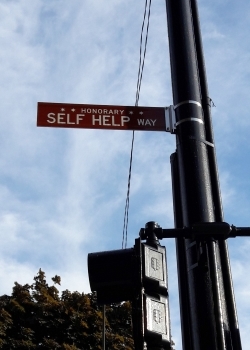
“If anyone can talk you out of writing, they should.” I think Harlan Ellison said that — at least, it sounds like something curmudgeonly he would say.
Here’s why you shouldn’t be a writer:
You’re not talented enough. Actually, this is a lie. Of course you have talent. We’re all born talented. Children love to make things, and so did you when you were young. Then you may have absorbed the Romantic Era myth of the artist as a hero who effortlessly produces works of staggering genius that are perfect in the first draft. You can’t do that. Neither can I. Neither could they. If you poke into the biographies of the great, heroic writers, you’ll find they studied hard, worked like dogs, and rewrote endlessly.
You’re too scared. This might be true. But what exactly are you afraid of? Making mistakes? Failure? Rejection? There are all kinds of fears. The Writer’s Book of Doubt by Aidan Doyle lists a wide variety of them. I own the book and I’m scared to read it, although the book also explains how fears can be overcome.
You might not know enough about the writing business. As a result, you have unrealistic expectations, whether you want to try traditional publishing or self-publishing. (Writing without the intent to publish is fine, of course, and if that’s your goal, ignore this paragraph.) However, you can learn about the business. The information is freely available, but…
You don’t want to work hard. And it’s going to be very hard work. This might be the most common reason for not writing. I don’t like to work hard, either. It’s lonely, sometimes boring, and, well, hard. There’s always more to learn, and it’s easy to get lost in books and conferences about writing rather than to sit down and write. Or to watch TV or doomscroll rather doing the research, planning, writing, rewriting, more rewriting, and even redrafting. “The first draft of anything is shit,” as Ernest Hemingway probably said.
When I talk to people who aren’t writers, rewriting turns out to be the thing they find impossible to understand. They can’t imagine needing to rewrite a dozen or more times.
When I talk to people who are experienced writers, they whine about how hard the work is, but they’ll rewrite until it’s right, and they’ll do all the other tasks the job involves. They’ve learned how to work hard.
Do you still want to write? Good. I wish you every kind of success, whatever success means to you. If you want more encouragement, I recommend this free comic, Art & Courage: A Guide to Sustaining a Creative Path, created by the Applied Cartooning Lab. It addresses all kinds of art, not just writing or cartooning.
And finally, here’s some writing advice that keeps me going:
“Write a little every day, without hope, without despair.” — Isak Dinessen. That is, you’ll have good days and bad days, sometimes good months and bad months, and letting it affect your self-definition or self-worth will leave you emotionally exhausted. You can’t write if you’re too tired.
For me, writing (and other art) contains within itself a constant source of joy. If you look at the faces of athletes as they enter a stadium or field, many wear big grins. They’re about to do the thing they love the most. They’ll get to work as hard as they can and as smart as they can. They can do their best. You can do that, too, if you choose a creative path, because excellence is always possible. Art lets you bring your whole self to your work.
March 5, 2025
“Journey to Apollodorus” at Oxygen Leaks Magazine

My novelette “Journey to Apollodorus” has just been published at Oxygen Leaks Magazine! Read it here.
In my novel Dual Memory, AIs on Earth are intrigued by a story about robots in Apollodorus Crater on the planet Mercury. In Chapter 36, the Prior Edifice system tells Par Augustus: “I know the true story of Apollodorus. It is based on an old human-created story about an imaginary machine society. The author arbitrarily placed it on Mercury in the same way that certain human stories take place in a land called Oz and include flying monkeys.” Yet Par insists that the story is true.
“Journey to Apollodorus” is the story they’re referring to. There are no flying monkeys in it. Instead, the story focuses on humans who struggle to create and maintain a scientific team when a lander sent to Mercury behaves unexpectedly. Success can be as stressful as failure.
February 26, 2025
I’m a Jade Ring judge
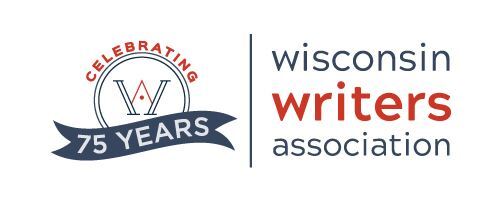
I’m the fiction judge for the Wisconsin Writer’s Association’s 2025 Jade Ring Contest. The fiction category is open to unpublished stories in English of up to 2000 words. There are also categories for poetry and non-fiction. You can find all the submission guidelines here.
Although I mostly write science fiction, I read and enjoy fiction of all kinds. As the guidelines say, though, the work should be complete and standalone.
I’ve judged contests in the past, so I know I’m going to enjoy this, and I’m hoping for a wide variety of stories. That’s what makes reading all the entries fun.



